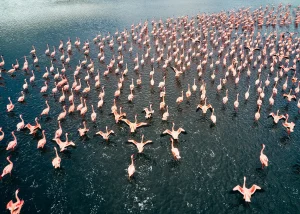Table of Contents
10 Best Birding Hotspots in Tanzania: Discover Hidden Avian Paradises
Tanzania is world-famous for its Big Five safaris and the Great Wildebeest Migration. But beyond lions, elephants, and rhinos lies another treasure: an extraordinary diversity of birds. With over 1,100 recorded bird species, Tanzania is one of Africa’s leading birding destinations. For keen birdwatchers, the country is a true paradise, offering everything from flamingo-filled lakes to forest canopies alive with colorful songbirds.
This guide will take you through Tanzania’s top birding hotspots, uncovering hidden trails, migratory wonders, and insider tips for an unforgettable avian adventure.
Why Tanzania is a Birdwatcher’s Paradise
- Incredible Diversity – Over 1,100 bird species, including endemic and near-endemic species like the Udzungwa Forest Partridge.
- Variety of Habitats – From the Serengeti plains to montane forests and Rift Valley lakes, Tanzania’s varied ecosystems provide multiple birding hotspots.
- Migratory Pathway – Tanzania is part of the East African Flyway, attracting migratory species from Europe and Asia.
- Year-Round Birding – While peak birdwatching is during the rainy season (Nov–April), many birding hotspots offer great sightings all year.
10 Best Birding Hotspots in Tanzania
1. Serengeti National Park
The Serengeti is not only a wildlife safari icon but also one of the best birding hotspots in Tanzania. Here, you’ll encounter ostriches striding across the plains, kori bustards (the heaviest flying bird), secretary birds hunting snakes, and countless smaller species.
2. Ngorongoro Crater
The Crater offers a natural amphitheater for birds. Flamingos gather on the alkaline lake, while highland forests host turacos, sunbirds, and hornbills. As one of Tanzania’s premier birding hotspots, Ngorongoro is excellent for both novice and seasoned birders.
3. Lake Manyara National Park
Known for its tree-climbing lions, Lake Manyara is also a flamingo haven. The shallow soda lake attracts thousands of pink flamingos, pelicans, and storks, making it a prime birding hotspot for waterbirds.
4. Tarangire National Park
Home to giant baobabs and large elephant herds, Tarangire also boasts over 500 bird species. The park is especially good for raptors, making it one of the richest birding hotspots in East Africa.
5. Lake Natron
This remote alkaline lake is the world’s main breeding ground for lesser flamingos. The surreal volcanic landscapes, coupled with huge bird colonies, make Lake Natron one of the most unique birding hotspots in Tanzania.
6. Ruaha National Park
Ruaha is vast and less crowded, providing excellent birding opportunities. Over 570 bird species live here, including fish eagles, kingfishers, and bee-eaters. It’s one of Tanzania’s most underrated birding hotspots.
7. Selous Game Reserve (Nyerere National Park)
Africa’s largest protected area is not just about wild rivers and elephants—it’s also a treasure for birders. The Rufiji River attracts wading birds, while miombo woodlands shelter many endemic species. This makes Selous a spectacular birding hotspot.
8. Udzungwa Mountains
A true hidden gem, the Udzungwa range is home to endemic species like the Udzungwa Forest Partridge and Rufous-winged Sunbird. For birders seeking rare sightings, this is a must-visit birding hotspot.
9. Pemba Island
Beyond Zanzibar, Pemba Island offers lush forests and mangroves with endemic birds like the Pemba white-eye and Pemba green pigeon. Birding here feels off the beaten path, making it a unique island birding hotspot.
10. Kilimanjaro & Mount Meru Slopes
Montane forests provide habitats for turacos, barbets, and sunbirds. The higher you climb, the rarer the species become. For trekkers, combining a mountain climb with birdwatching creates an unforgettable birding hotspot experience.
When is the Best Time for Birding in Tanzania?
While wildlife safaris peak in the dry season, birders find the green season (November to April) particularly rewarding. This is when migratory species arrive and local birds display breeding plumage. However, many birding hotspots offer incredible sightings year-round.
Tips for a Successful Birding Safari
- Bring Binoculars – A good pair of binoculars is essential for spotting birds in distant canopies.
- Use Field Guides – Local birding guides and apps can help identify species.
- Hire Specialist Guides – Tanzania has expert birding guides who know exactly where to find rare species.
- Be Patient and Quiet – Many birds are shy and require stillness to observe.
Cultural Connections: Birds in Tanzanian Traditions
Birds hold cultural and spiritual importance across Tanzania. For example:
- The Maasai associate certain birds with omens or blessings.
- Local proverbs use birds to symbolize wisdom, freedom, and resilience.
- Communities living near birding hotspots often integrate bird sightings into seasonal farming or fishing calendars.
Sample 7-Day Birding Itinerary in Tanzania
Day 1: Arrival in Arusha – birding at Lake Duluti.
Day 2: Tarangire – baobab landscapes and raptor sightings.
Day 3: Lake Manyara – flamingos and waterbirds.
Day 4: Ngorongoro Crater – highland species.
Day 5-6: Serengeti – grassland birds and migratory species.
Day 7: Lake Natron – flamingo breeding colonies.
This itinerary covers multiple birding hotspots in a single trip.
Responsible Birdwatching
While exploring Tanzania’s birding hotspots, it’s vital to practice eco-friendly tourism:
- Stick to designated trails.
- Avoid disturbing nests.
- Support conservation lodges that protect bird habitats.
Why Tanzania Should Be on Every Birder’s Bucket List
Tanzania isn’t just about big game safaris. Its birding hotspots reveal another layer of the country’s natural wealth. Whether you’re an amateur or seasoned birder, you’ll find unmatched variety, stunning landscapes, and a sense of discovery in every bird call.
From the Serengeti plains to the misty Udzungwa forests, Tanzania’s birding hotspots provide unforgettable opportunities for birdwatchers. With over 1,100 species waiting to be discovered, Tanzania is not just a safari destination—it’s a world-class birding paradise.






